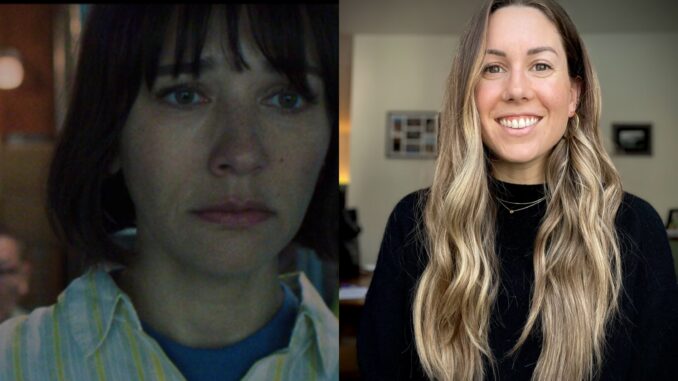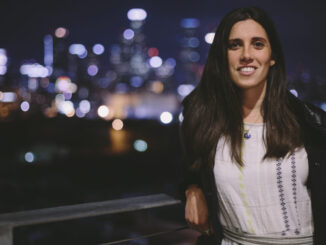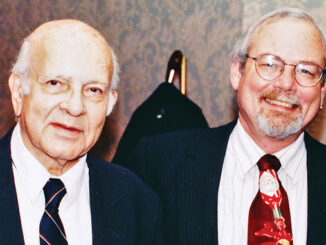
By Rob Feld
Amelia Allwarden’s journey into film editing began with a childhood fascination with storytelling.
“Ever since I was a kid, I loved movies and books,” she says. This passion intensified when she stumbled upon the bonus features of a “Harry Potter” DVD, where she discovered a section called “The Magic of Editing.” This feature allowed her to recut scenes and witness the profound impact of editing choices. From that moment, Amelia was hooked.
She wasn’t able to get into the film schools she applied to, but she wasn’t deterred. She created her own major in college, combining visual arts, film theory, and practical experience. This self-driven approach laid a solid foundation for her career, ultimately leading to her selection for the ACE internship program. This opportunity opened doors, providing mentorships and invaluable on-the-job learning.
Allwarden recently completed work on Katie Robbins’ series, “Sunny,” cutting Episodes 2, 4, and 8. The series follows Suzie Sakamoto (Rashida Jones), an American living in Japan, who is thrust into a mystery after her husband Masa (Hidetoshi Nishijima) and son Zen (Fares Belkheir) disappear in a plane crash. Set in a near-future Japan, Suzie receives a robot named Sunny (voiced by Joanna Sotomura), programmed by Masa, as a condolence gift.
Initially resistant due to her technophobia, Suzie gradually teams up with Sunny to uncover the truth behind her family’s disappearance. The series blends sci-fi, comedy, and thriller elements as Suzie discovers unexpected facets of her husband’s life, encounters a conspiracy involving Masa’s tech firm, and navigates the dangerous world of bot-hacking and the criminal underworld.
Allwarden’s genre-spanning background proved crucial in her work on “Sunny,” a show that blends various tones and genres, requiring a nuanced and instinctive touch.
CineMontage: Tell me what the ACE internship afforded you.
Amelia Allwarden: Oh, it gave me everything. My whole career really started in LA when I participated in that internship program. The biggest thing that it gave me was the door open to have coffees with people, and having people’s email addresses and having people allow me to ask them questions. Also shadowing in cutting rooms, learning how to be an assistant editor, all the things. I didn’t know how to be an assistant editor. I didn’t know what dailies were because I didn’t go to film school. Luckily a little less than a year after participating in that internship, I was an assistant editor on a pilot with Doc Crotzer, who became my first mentor. He taught me a new way to look at editing.
CineMontage: What was that?
Allwarden: Because I was so green, I thought at the time that editing was either something you have or you don’t. I learned from him how much you can learn on every job when you’re open to learning. For example, he’d have two versions of a scene and he would be kind enough to invite me into his office and say, “I’m going to play you two versions of the scene. Which one do you like better and why?” It wasn’t a test; he genuinely wanted my opinion and to have a collaborator there with him. If I didn’t provide an explanation that he felt was genuine, he would know. I started looking at editing through a lens of emotion and feeling. Before that, I saw it much more technically, so he opened it up to be emotional and instinctive. He’s still my No. 1 mentor. He’s a huge advocate for me. He was a big reason why I moved up from an assistant editor to editor.
CineMontage: Talk to me about the workflow of “Sunny.”
Allwarden: “Sunny” was such an interesting show because it is a mixture of a lot of different tones, and that was really what drew me to it. My background in editing is in a variety of genres, which I love because I can work on projects that blend those things. That was really important to the showrunner, Katie Robbins, and the EP director, Lucy Tcherniak. We collaborated closely on iterating the tone. Editing in Japanese was a challenge too, especially in Episode 4, which was mostly in Japanese. We worked with Charlize Toratani, our assistant editor who is fluent in Japanese, translating the script and syncing it so we could focus on performances. Every sequence was always balancing the tone for its specific need. For example, in the opening of Episode 2, there’s a sequence showing what’s called Radio Taiso, exercises done in corporate Japan. There were various ways that scene could have been edited—purely comedic, much more tense, or somewhere in the middle. We worked on many versions of that sequence to make sure we were going down the perfect path. “Sunny” could be edited in many different ways and manipulated to be what it needed to be at any moment.
CineMontage: You can’t set a rule for the show; you’ve got to be completely on your toes and use all those instincts you have.
Allwarden: Definitely. It’s scene-by-scene because the tone can change within the same scene. It was much more instinctual rather than having a set tone for the entire show.
CineMontage: Compared to what you were told when you first took the job, did the show evolve into something different? Did it surprise everyone?
Allwarden: When I took the job, it was heavily focused on being funny because the scripts are hilarious but also driving. I wanted to figure out what was going to happen next. It was important to balance humor with the thriller and mystery elements, creating a unique tone. I knew that going in, and I wanted to be a little quirky or take chances. For example, I might let something live in a wide shot longer in a comedy or bounce between singles in a drama. It was about figuring that out as we went.
CineMontage: What kind of footage or coverage are you receiving to work with? Is it storyboarded meticulously? Especially with the robot/puppet’s choreography, how does that tie your hands?
Allwarden: It depended on the scene. Some sequences, like the bathhouse sequence in Episode 4, were heavily storyboarded. Lucy shared those with me early on so we could iterate before shooting. But she also got a lot of options on the day, balancing intentional directing with the freedom to play. The coverage allowed us to be intentional about the shots we used, especially with Susie, who’s a closed-off character. We wanted to peek into her emotional headspace with close-ups, making those moments feel intentional.
CineMontage: How are you choosing performances within this context? And with the robot, are you manipulating performance in post-production to meet the tones you’re figuring out as you go?
Allwarden: We had Weta Workshop create the Sunny puppet, live-captured on set with roboticists operating her and Joanna Sotomura playing Sunny. Rashida Jones could hear Joanna through a speaker in the puppet. Sunny’s facial expressions were captured in-camera via Joanna’s performance and translated to the robot. We could manipulate those in post if needed, like ADR for Sunny’s face or changing expressions, but that was not the majority of what we did. We had options to recalibrate performances globally if we needed more humor or sadness. Joanna’s audio could be taken from any take and matched with the face, giving us endless opportunities to manipulate the performance.
CineMontage: Talk to me about tracking the narrative arc, especially with a character who is internal and closed-off. How do you keep us involved?
Allwarden: That was one of the more interesting challenges. We were intentional about picking moments to be more internal with Susie. As we unravel throughout the series, some of those moments were scripted and we come into more of her emotional headspace. And then some of those moments we had to craft and post when we realized we wanted to be more internal. We looked at the show globally to see where we needed more access to her internal life. Tyler Cook and Taichi Erskine, who edited Episodes 1 and 3, and I watched the first three episodes together and discussed Suzy’s emotional headspace, reshaping scenes with score, sound, and shot choice.
CineMontage: What did you take away from this series?
Allwarden: The theme of loneliness resonated with me. It became about calibrating the way Sunny begins to mimic Susie or understand how she wants to be interacted with so that she can gain emotional access to her, and help her open up. It’s a stepping stone to talking to real people again after this tragic event. One of the goals of the series was a conversation about AI and technology and the ways it can be in this fictional world. So when we were making this near-futuristic, yet retro, familiar feeling Japan, we were working a lot on the sound design of the world and making it feel really analog. The sound design avoided traditional sci-fi beeps and boops, opting for soft, analog, organic sounds. Familiar but new but old. All of these things fused when we were working on post.






